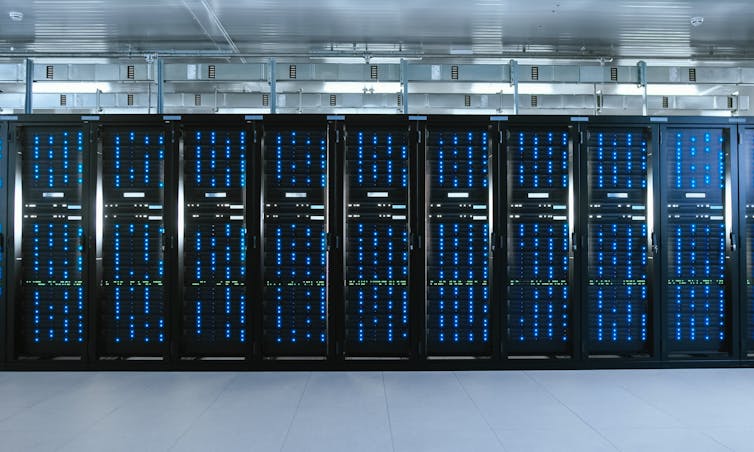The boom in artificial intelligence has already changed the way we understand technology and the world. But developing and updating AI programs requires lots of computing power. This relies heavily on data center servers, which comes at a high cost in terms of carbon emissions and resource usage.
A particularly an energy-intensive task is “training”where generative AI systems are exposed to large amounts of data in order to improve what they do.
The development of AI-based systems has been blamed for an increase of 48% in Google greenhouse gas emissions over five years. This will make it harder for the tech giant to meet its goal of reaching net zero by 2030.
Some industry players justify the additional energy expenditure related to AI by highlighting the benefits this technology could have in terms of environmental sustainability and climate action. Improving solar and wind energy efficiency with predict weather conditions, “Smart” agriculture and more efficient autonomous electric vehicles are among the so-called benefits of AI for Earth.
It is in this context that technology companies are looking to renewable energies And nuclear fission to supply electricity to their data centers.
Nuclear fission is the type of nuclear energy used around the world for decades. It releases energy by splitting a heavy chemical element to form lighter ones. Fission is a thing, but some in Silicon Valley think a different technology will be necessary to bridge the gap: nuclear fusion.
Unlike fission, nuclear fusion produces energy by combining two light elements to make a heavier one. But fusion energy represents an unproven solution to the AI sustainability challenge. And tech CEOs’ enthusiasm for this technology as an energy supply for AI risks marginalizing the potential benefits for the planet.
Beyond the conventional
Google recently announced that it signed an agreement buy energy small nuclear reactors. It is a technology based on nuclear fission that can produce useful amounts of energy from devices much smaller than the enormous reactors of large nuclear power plants. Google plans to use these small reactors to generate the energy necessary for the development of AI.
This year, Microsoft announced an agreement with the company Constellation Energy, which could pave the way for restarting a reactor at the Three Mile Island nuclear power plant in Pennsylvania, scene of the worst nuclear accident in United States history.
However, nuclear power produces long-lived radioactive waste, which must be stored safely. Nuclear fuels, such as the element uranium (which must be mined), are limited and therefore this technology is not considered renewable. Renewable energy sources, such as solar and wind, suffer from “intermittency,” meaning they do not produce energy consistently at all times of the day.

Jamesonwu1972 / Shutterstock
These limitations have led some to consider nuclear fusion as a solution. Most notably, Sam Altman of OpenAI has expressed particular interest In Helion Energya fusion startup working on a relatively new technology design.
In theory, nuclear fusion offers a “Holy Grail” energy source by generating large amounts of energy from small quantities of fuel, with no greenhouse gas emissions from the process and relatively little waste. radioactive. Some forms of fusion rely on a fuel called deuterium, a form of hydrogen, which can be extracted from an abundant source: seawater.
In the eyes of its advocates, like Altman, these qualities make nuclear fusion well-suited to meet the challenges of growing energy demand in the face of the climate crisis – and to meet the broad requirements of AI development.
However, digging below the surface, the picture is not so rosy. Despite the hopes of their supporters, fusion technologies have not yet produce sustained net energy production (more energy than is needed to run the reactor), let alone produce energy at the scale required to meet the growing demands of AI. The merger will require many additional technological developments before it can deliver on its promise of delivering electricity to the grid.
Rich and powerful people, like CEOs of giant tech companies, can strongly influence how new technologies are developed. For example, there are many different technological methods for achieving nuclear fusion. But the particular path to fusion that is useful for meeting the energy demands of AI may not be the one that is ideal for meeting people’s general energy needs.

Dil_Ranathunga / Shutterstock
The overvaluation of innovation
Innovators often take for granted that their work will produce ideal social outcomes. If fusion can work at scale, it could make a valuable contribution to decarbonizing our energy supplies as the world seeks to tackle the climate crisis.
However, the humanitarian promises of fusion and AI often seem to be sidelined in favor of scientific innovation and progress. Indeed, when looking at who is investing in these technologies, it is worth asking who is really benefiting from them.
Will investment in AI fusion enable its wider adoption as a clean technology to replace dirty fossil fuels? Or will a vision of technology propagated by powerful tech companies limit its use for other purposes?
It can sometimes feel like innovation itself is the goal, without considering its broader impact. This vision echoes the motto of Meta CEO Mark Zuckerberg, “Move fast and break things”where short-term losses are accepted in pursuit of a future vision that will later justify the means.


